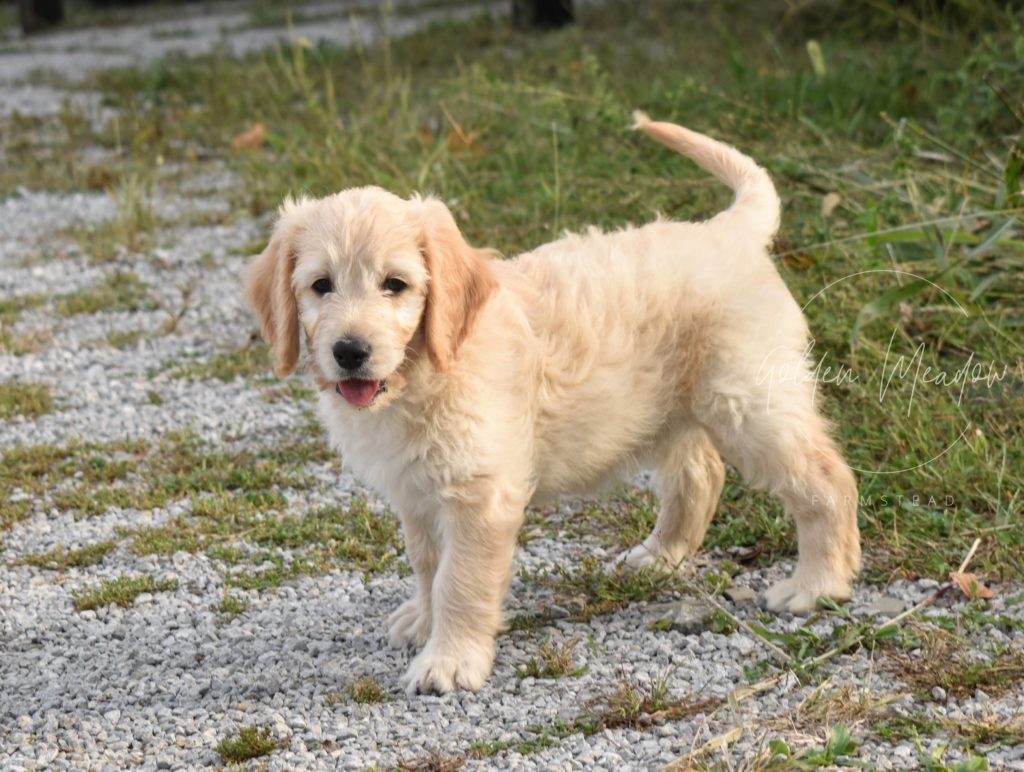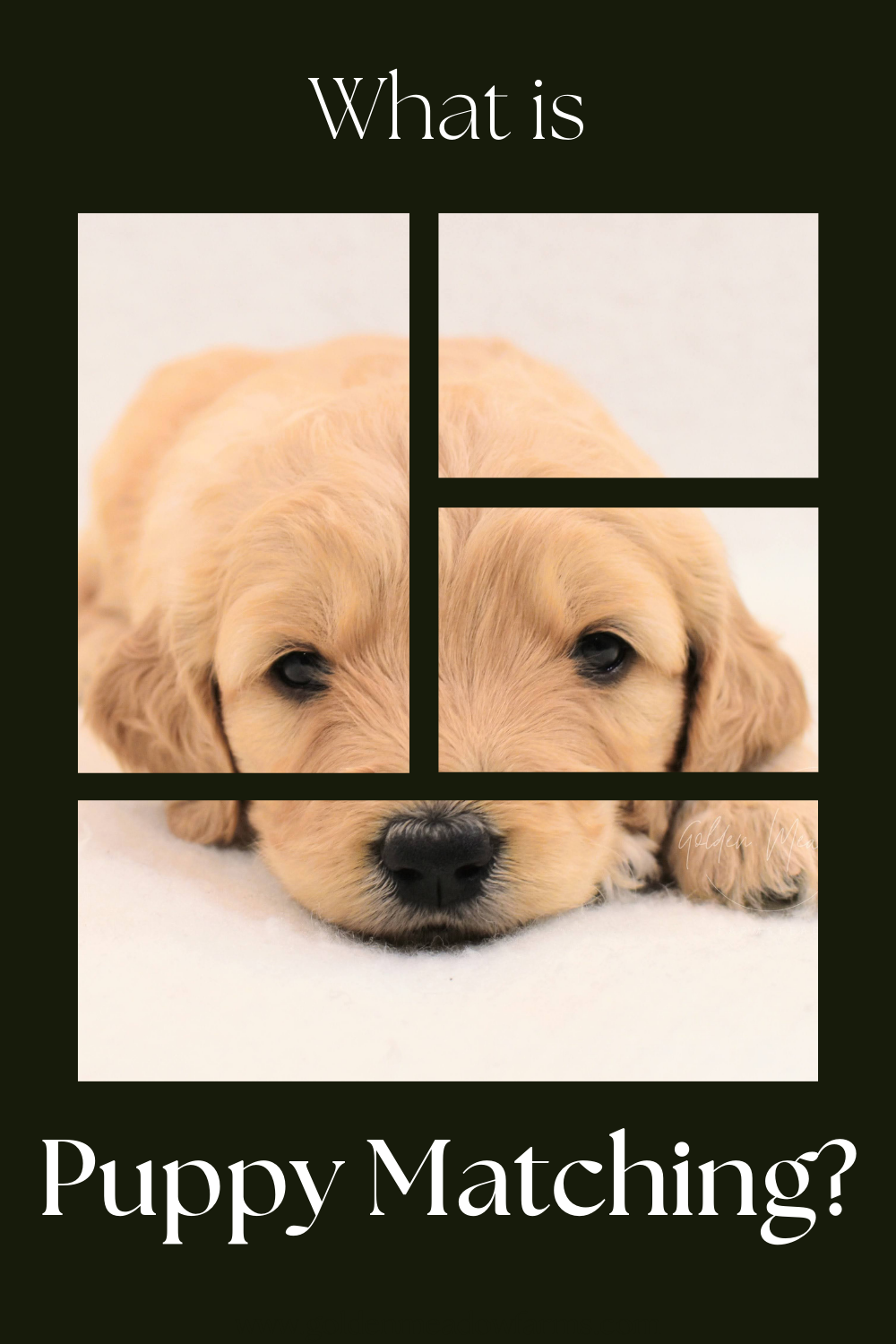When you buy a puppy from Golden Meadow Farmstead, we want to be sure that your new puppy is a life long companion. We work towards that goal in everything we do with your puppy. From only breeding healthy mamas, to implementing ENS and socializing your puppy, to puppy matching, breeding a puppy ready for your lifestyle is important to us.
So what is Puppy Matching, and how does it work?
Puppy Matching is the process of pairing the right dog with the right owner. There are a few key pieces of this process you should know about. There is no bad puppy, but a puppy in the wrong environment can prove a challenge to train.
Puppy Atitude Testing
The first thing to know about Puppy Aptitude Testing, is that this is not a personality test. Your puppies new personality will be shaped by the experiences and socialization it experiences while with us and after they join your family. Volhard’s Puppy Aptitude Test was first developed to help determine a dog’s suitability as a service dog. After all, training a service dog is an important investment, and knowing if the puppy is likely to succeed is important.
At Golden Meadow Farmstead, we hire a professional dog trainer, who is well versed in Volhard’s Puppy Aptitude Test to perform testing when the puppies are 7 weeks old. This is only one week before they join your family.
Tell the breeder about yourself
We use a puppy matching form to collect information about you, your lifestyle, and what you are hoping for in a dog. The more information you can add to the form, the better. We ask questions about where you live, what other pets you may have, who lives in your home. Use the puppy matching form to tell us about what activities you are hoping to do with your dog. We also want to know what size and gender preferences you have in a dog, as this is also an important part of the matching process.
Everyday Experiences
After 7 weeks of intentional interactions with all of the sweet puppies in a litter, we have collected a large amount of anecdotal information about each pup. Your puppy has already had a lot of firsts! We have been keeping a close eye how they play with their littermates as well as their reactions to various types of socialization. While not as quantitative as the aptitude test, we compile these notes for the trainer testing each of the puppies.

Puppy Aptitude Test
The trainer performs the exercises of the puppy aptitude on each puppy. The puppies have never met the trainer, and the testing happens in an environment that is new to them as well.
I copied the trainer’s notes after temperament testing an F1b goldendoodle puppy below. As you read through it, notice that each exercise she performed, she learning something very practical about the puppy’s nature.
He had mostly 3’s and 4’s (total 5) will be a happy dog, should be good with children, and will do well with training. Disburse energy with plenty of exercise. A family companion.
To test the ease of training you look at “Social attraction”, “Following” and “Retrieving”. He tested with 2’s on the first 2 (came and followed readily/tail up/got underfoot) the retrieve was a 4 (chased and returned without it to tester).
He tested a 4 (struggled, then settled with some eye contact) on the restraint and a 1 on the touch sensitivity. He will do well with positive reinforcement and if an Invisible fence is used – a medium/high setting on the collar may be required.
On the elevation dominance he settled, then struggled. This tests the degree of acceptance of a situation where they have no control, ie vet or groomer.
In addition to from the vet and groomer, the dominance test is important to pay attention to when evaluating a puppy for a home with children. If he settles during this test, then he will be okay with children who inevitable put him in situations that are out of its control.
His response to the sight sensitivity (moving object) was a 2 (looked, put feet and mouth on object) which indicates his prey drive may be on the higher side.
Because of his higher prey drive, this puppy might be really good annoying the family cat! We can avoid that challenge for the family with a cat by matching them with a different puppy who has a lower prey drive.
The sound sensitivity tests how they may react to sounds such as thunderstorms or gun shots (for field dogs). He listened and located the sound but was not overly concerned.
We look to match a dog with strong sound stability with homes who have a lot going on in their homes. This dog would be content in a home who has louder young children. Sound stability is not as important for a couple with no children who want to take the puppy on walks and otherwise want a snuggly couch potato.
The stability is where you use the umbrella which is their response to a strange object. He looked and went to investigate (no stress).
If a new owner plans to do therapy work with her new puppy, she needs a puppy who does not demonstrate sound, sight or touch sensitivity. Any of our puppies can be worked with to not be bothered by those things, but some puppies are more naturally gifted at it that others (not every dog enjoys therapy work).
His energy appears to be on the medium side.
A lower energy puppy is a great candidate for a condo or apartment lifestyle with no yard. A bored puppy is going to get into mischief simply because it’s board. A medium puppy we want to put in a home with a fence and an active lifestyle where the dog will have plenty of opportunity to spend that energy in a positive way.
Summary: Medium energy that will require plenty of exercise, positive training and strong leadership. He has a strong play drive and should get along with children as well as elderly people. He also has a strong pack drive and wants to please. His tail never stopped wagging. He is confident, but not overly so. He is also outgoing an eager to please, but needs a firm hand or he will make a pest of himself, though he was able to play alone as long as he knew I was in the room. In the testing did exhibit a desire to not be left alone. That does not show in the testing, just that he wants to be with people.
It takes about 5 to 10 minutes to perform the Puppy Aptitude Test on a puppy. In less than 10 minutes, the trainer was able to learn a lot about this puppy that will ultimately help us to cultivate happy puppies and happy homes.
After the trainer has completed testing and reviewed the information in the puppy matching forms, the matching begins. This is where they determine which puppy is best for each home. This process usually takes some time. We do not consider order of deposit during the matching process, because we are interested in finding the puppy most suited for your home.
The Results
Puppy Matching is an exciting and emotional day. This is the moment, that the ownership starts to change from our hands to yours. When we let you know which puppy is yours, we start using the name you picked out for them. If you brought us a blanket or crate at puppy meet and greet, we making sure that your specific puppy access to those resources.

